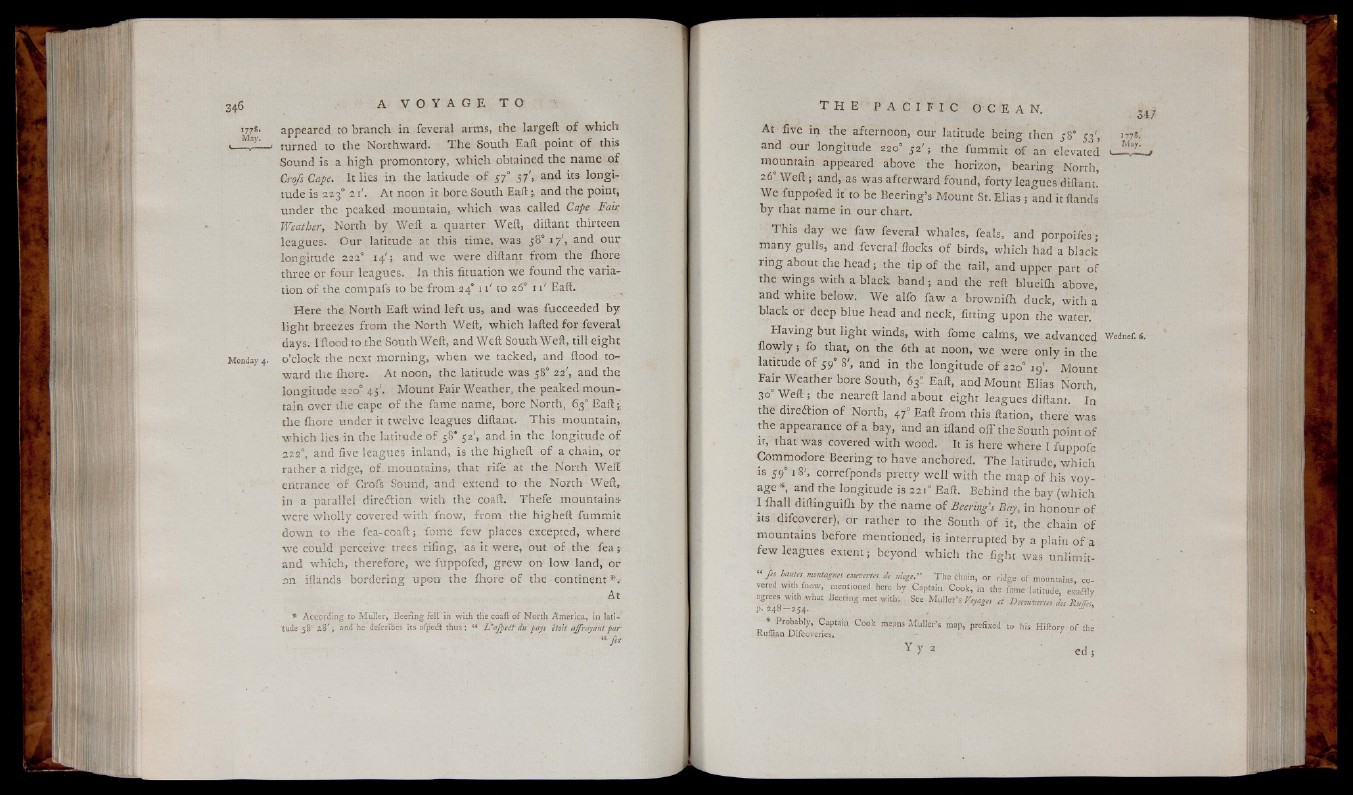
appeared to branch in feveral arms, the largeft o f which
turned to the Northward. T h e South Eaft point o f this
Sound is a h igh promontory, .which obtained the name o f
Crofs Cape. It lies in the latitude o f 37° 57', and its longitude
is 223° 21'. At noon it bore South Eaft; and the point,
under the peaked mountain, w hich was called Cape Fair
Weather, North by Weft a quarter Weft, diftant thirteen
leagues. Our latitude at this time, was 58° 17', and o u r
longitude 222° 14'; and we were diftant from the ihore
three or four leagues. In this fituation w e found the variation
o f the compafs to be from 24“ 11' to 26° 11' Eaft.
Here the North Eaft wind le ft us, and was fucceeded b y
ligh t breezes from the North Weft, w hich lafted for feveral
days. Iftood to the South Weft, and Weft South Weft, till eight
o’clock the next morning, when we tacked, and flood toward
the ihore. At noon, the latitude was 58° 22', and the
longitude 220° 45'. Mount Fair W eather, the peaked mountain
over the cape o f the fame name, bore North, 63° E a ft;
the ihore under it twelve leagues diftant. This mountain,,
which lies in the latitude o f 58’ 52', and in the longitude o f
222°, and five leagues inland, is the higheft o f a chain, or
rather a ridge, o f. mountains, that rife at the North Weft
entrance o f Crofs Sound, and extend' to the North Weft,
in a parallel direftion w ith the coaft. Thefe mountains
were w ho lly covered with fnow, from the higheft fummit
down to the fea-coaft;. fome few places excepted, where
w e could perceive trees riling, as it were, out o f the fea j
and which, therefore, we fuppofed, g rew on low land, o r
an iflands bordering upon the ihore o f the continent
At
* According to Muller, Beenng fell in with the coaft o f North America, in lati-f
tude 58° 2,8'j and he defcribes its afpe& thus: M L'afpeS? du pays etoit affrayantpar
fe s
T H E P A C I F I C OC E A N. ,, 7 - OT/
At five in the afternoon, our latitude b e in g then 38° 53', 1778.
and our longitude 220° 52 '; the fummit o f an elevated 1 t
mountain appeared above the horizon, bearing North,
260 Weft ; and, as was afterward found, forty leagues diftant!
We fuppofed it' to be Beering’s Mount St. Elias ; and it Hands
b y that name in our chart.
This day we faw feveral whales, feals, and porpoifes;
many gu lls, and feveral flocks o f birds, which had a black
r in g about the h e ad ; the tip o f the tail, and upper part o f
the wings with a bla ck b a n d ; and the reft blueifti above,
and white below. We alfo faw a browniih duck, with a
black or deep blue head and neck, fitting upon the water.
Having but ligh t winds, w ith fome calms, we advanced Wednef. s.
f lo w ly ; fo that, on the 6th at noon, we were only in the
latitude o f 59° 8', and in the longitude o f 220° 19'. Mount
Fair Weather bore South, 63? Eaft, and Mount Elias North,
30° Weft ; the neareft land about eight leagues diftant. In
the direftion o f North, 47° Eaft from this ftation, there was
the appearance o f a bay, and an ifland o ff the South point o f
it, that was covered w ith wood. It is here where I fuppofe
Commodore Beering to have anchored. The latitude, which
is J9° 18', correfponds pretty w e ll with the map o f his voyage
| and the longitude is 22 j° Eaft. Behind the bay (which
I Hi all diftinguifh by the name o f Beering’s Bay, in honour o f
its difcoverer), or rather to the South o f it, the chain o f
mountains before mentioned, is interrupted by a plain o f a
few leagues extent; beyond which the fight was unlimit-
“ fe s houses monta'gncr convenes de niege." T h e chain, or ridge- o f mountains covered
with fnow, mentioned here by Captain Cook, in the fame latitude, exafflv
agree* with-what Beenng. met with;,, See Muller’s Voyages eS Decouvertes des R n jes ' P. 248—254. i / **/ *
* Probably, Captain Cook means Muller’s map, prefixed to his Hiftory o f the
Ruffian Difcoveries, -